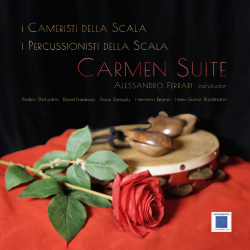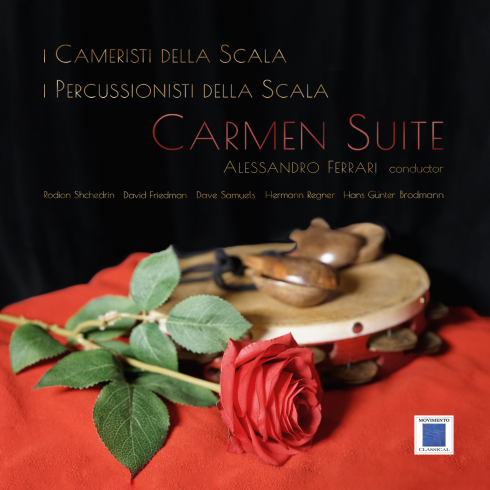

Carmen suite
Carmen suite
The ninety-year -old Russian composer Rodion Shchedrin, born in Moscow in 1932, is best known tor his 1967 ballet adaptation of Bizet's Carmen. This work breathes new lite into the music and deserves to be appreciated more as a creative tribute than a simple arrangement. In fact, the score possessed such inventiveness and energy that alter its composition it soon began to circuiate internationally as a concert suite. A recording like the one you can hear on this album, made by the percussionists and Chamber Orchestra of the La Scala opera house, is in fact a pleasure to listen to even without the staging.
The ballet was written on source materiai trom Bizet's famous opera and dedicateci to Shchedrin's wife Maya Plisetskaya, a prima ballerina at the Bolshoi Theatre in Moscow, whom tor many years had asked in vain Dmitri Shostakovich and Aram Khachaturian tor an adaptation, before her husband accepted the commission. The originai idea of a ballet version based on motifs tram Prosper Merimee's story, with a libretto commissioned tram the Cuban choreographer Alberto Alonso, did not convince Shchedrin, who, overawed by the superiority of the operatic materiai, chose "not to pay obsequious homage to the genius of Bizet , butto approach the work creatively''. Scoring far an unusual combination of strings, timpani and tour percussion groups, Shchedrin used motifs noi only tram the opera, but also tram the Arlesienne Suite No. 2 and the opera La jolie fil/e de Perth. The result is a novel and rhythmically lucid arrangement tor string orchestra, five timpani, and tour percussion groups that contain practically all possible types of percussion instruments, tram marimba to vibraphone, tram bongos to maracas, tram castanets to crotals, guiros to cowbells. Two elements emerge prominently in Shchedrin's writing:
firstly , the creative juxtaposition of the two powerful instrumental groups - strings set in contrast to an imposing array of dynamically graduateci percussion instruments -
and secondly, the insistence on departing tram Bizet's classicism. Far example, there are no horns in the piece, but the most memorable melodies stili find their way out, and this determines an immediate stylistic difference. There are metric shifts, sudden rhythmic changes, arresting phrasing and sonic atmospheres that surprise the listener at every turn, making tor a witty and ironie atmosphere - as an example it's sufficient to listen to the beginning of the famous Habanera, entrusted to vibraphone duet and timpani , or the even more famous Toreador scene that in Shchedrin's version begins with a crescendo roll of drums and then suddenly stops.
In the balle!, Carmen's story is told in flashbacks. The balle! begins with the execution of Don José, who has been condemned alter killing Carmen, his lover. In his last moments he has a vision of the most important moments of his story: Carmen, a cigarette factory giri, clashes with the other workers and is arrested by the guards - Don José among them - but she then seduces Don José, who has her released. Later though, Don José discovers Carmen's passion tor the famous bullfighter Escamilla , tor whom she intends to leave him, and he is so infuriateci that he stabs Carmen to death in a fit of jealousy.
In his adaptation of the score Shchedrin chose the best-known numbers from the opera. A short lntroduction (Andante assai) is immediately followed by a Dance (Allegro), a First Intermezzo (Allegro moderato) and the Changing of the Guard (Moderato) with its grotesquely exaggerated accentuation of individuai notes, which stagnate the flow of the melody . Then there is the apparition of Carmen, with the Habanera (Allegro moderato). This is followed by a Scene (Allegro moderato) and a Second Intermezzo (Larghetto).
The Farandole tram the end of the Second Suite from L'Arlesienne starts the seventh movement but this rapidly turns into the Bolero (Allegro vivo), followed by two of the Toreador's numbers (Moderato con stoltezza and Lento) and the bullfight music. Alter an Adagio and an Andantino, Carmen Suite concludes with an Allegro finale. In the coda, alter a grandiose crescendo, Shchedrin entrusts the theme of the Habanera to hypnotic and distant bells, accompanied by a delicate string pizzicato.
The technical skill required of the percussionists in performing the Carmen Suite is quite remarkable ; 47 different instruments are used in the score. However, this seems to have stimulated the La Scala musicians into a further display of virtuosity and expressiveness in the three pieces for percussion alone that make-up this recording 's three final tracks: Carousel by David Friedman and Dave Samuels is an incredible duet for vibraphone and marimba, originally performed by the composers in a duo under the title Double lmage.
lt is a glorious improvisation, starting out from a given compositional scheme.
The open-endedness of the piece is emphasized in this arrangement by the Scala percu s sionists' addition of timpani and drums.
In Changing Patterns, the title itself describes Hermann Regner's piece tor percussion quarte!, which requires a continuous overlapping of patterns, spacial distribution and a wide range of dynamics produced with the bare hands, all making tor the strong sense of rhythm and lnterplay that emerges in this recording.
The last piece, Greetings to Hermann by the eclectic German musician and filmmaker Hans-GOnter Brodmann, is for membrane instruments only and takes us into territory strongly influenced by jazz and jazz textures, letting the percussionists juggle between mastery of different musical languages.


I Cameristi della Scala
The chamber orchestra Cameristi della Scala, formed by the musicians of the orchestra of Teatro alla Scala di Milano, was founded in 1982. The orchestra has a unique identity in which they regularly perform in the formation with and without a conductor. Its core repertoire includes many masterpieces of music written for chamber orchestra spanning from the 18th century to the present day, in addition to promoting and championing works by the lesser known composers.

